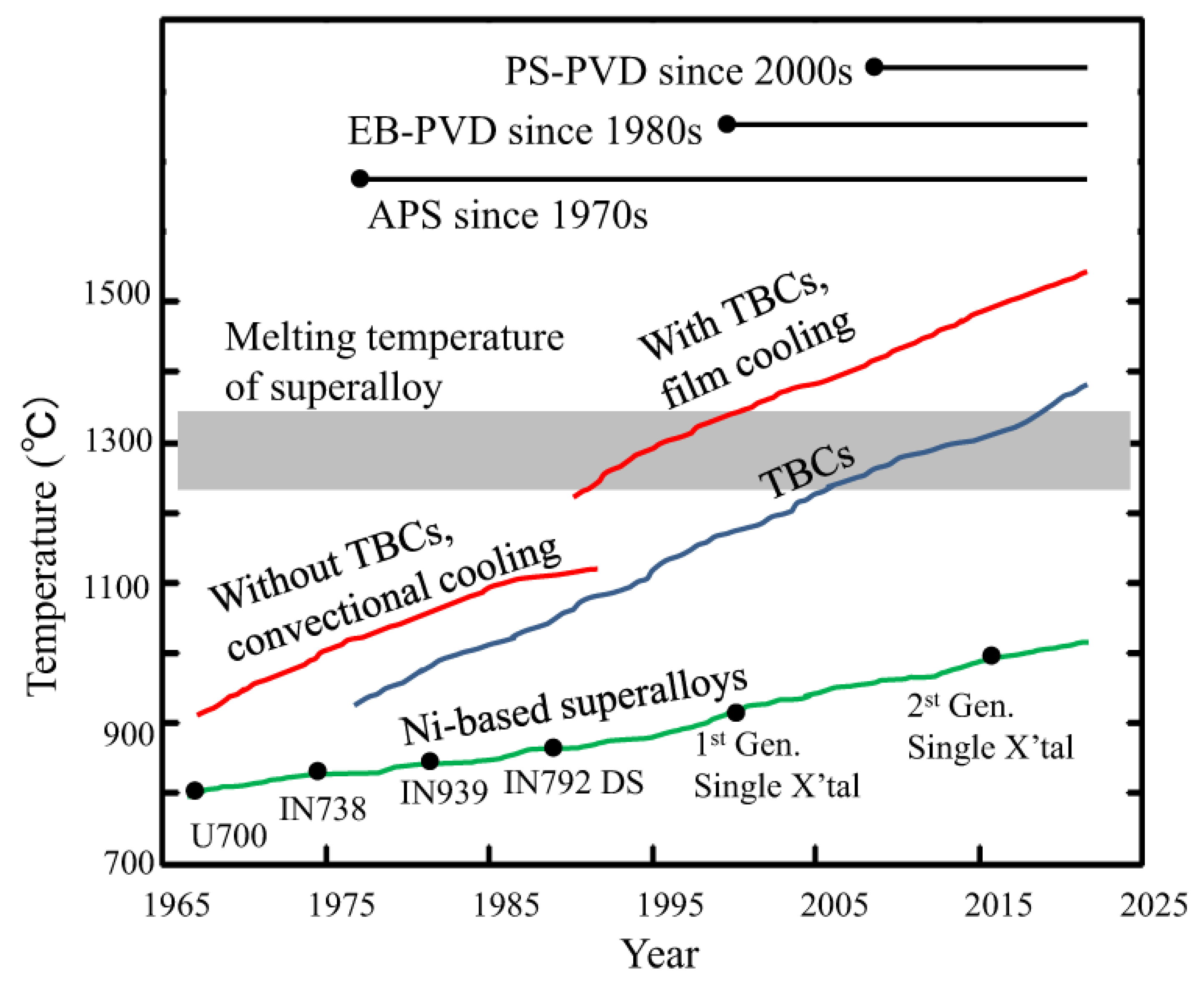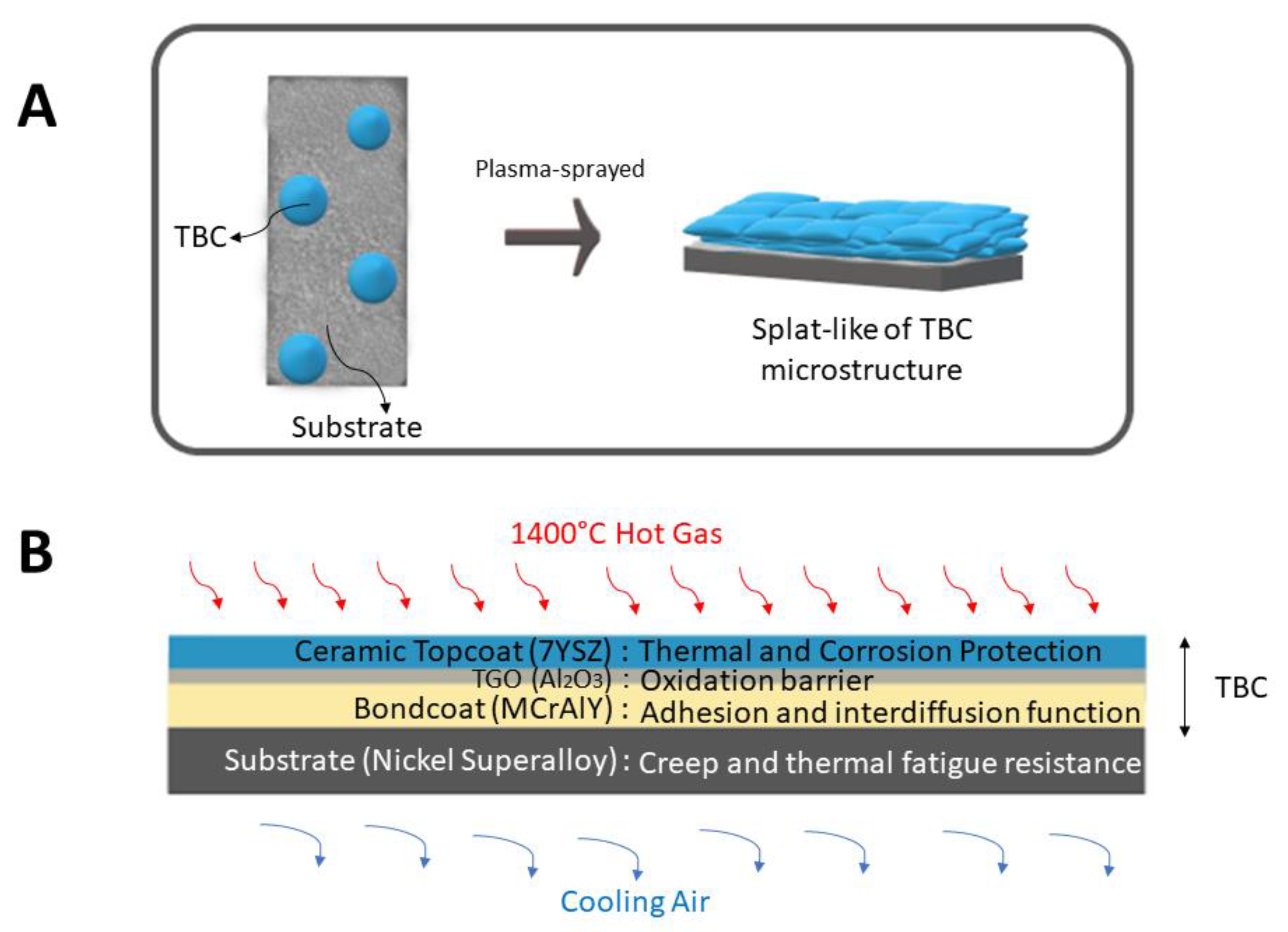Thermal Barrier Coatings: An Insight into Conventional Plasma Spray and Water-Stabilized Plasma Spray
Abstract
:1. Introduction
2. Arc Plasma Methods
3. Atmospheric Plasma Spray
4. Water-Stabilized Plasma Spray
5. Future Work and Conclusions
Author Contributions
Funding
Institutional Review Board Statement
Informed Consent Statement
Data Availability Statement
Conflicts of Interest
References
- Łatka, L. Thermal Barrier Coatings Manufactured by Suspension Plasma Spraying—A Review. Adv. Mater. Sci. 2018, 18, 95–117. [Google Scholar] [CrossRef] [Green Version]
- Zhang, X.; Deng, Z.; Li, H.; Mao, J.; Deng, C.; Deng, C.; Niu, S.; Chen, W.; Song, J.; Fan, J.; et al. Al2O3-modified PS-PVD 7YSZ thermal barrier coatings for advanced gas-turbine engines. Npj Mater. Degrad. 2020, 4, 31. [Google Scholar] [CrossRef]
- Clarke, D.R.; Oechsner, M.; Padture, N.P. Thermal-barrier coatings for more efficient gas-turbine engines. MRS Bull. 2012, 37, 891–898. [Google Scholar] [CrossRef] [Green Version]
- Odhiambo, J.G.; Li, W.; Zhao, Y.; Li, C. Porosity and Its Significance in Plasma-Sprayed Coatings. Coatings 2019, 9, 460. [Google Scholar] [CrossRef] [Green Version]
- Pham, D.Q.; Berndt, C.C.; Cizek, J.; Gbureck, U.; Zreiqat, H.; Lu, Z.; Ang, A.S.M. Baghdadite coating formed by hybrid water-stabilized plasma spray for bioceramic applications: Mechanical and biological evaluations. Mater. Sci. Eng. C 2021, 122, 111873. [Google Scholar] [CrossRef]
- Hrabovský, M. Generation of thermal plasmas in liquid-stabilized and hybrid dc-arc torches. Pure Appl. Chem. 2002, 74, 429–433. [Google Scholar] [CrossRef]
- Xu, H.; Guo, H.; Gong, S. 16—Thermal barrier coatings. In Developments in High Temperature Corrosion and Protection of Materials; Gao, W., Li, Z., Eds.; Woodhead Publishing: Sawston, UK, 2008; pp. 476–491. [Google Scholar] [CrossRef] [Green Version]
- Matějíček, J.; Chráska, P.; Linke, J. Thermal Spray Coatings for Fusion Applications—Review. J. Therm. Spray Technol. 2007, 16, 64–83. [Google Scholar] [CrossRef]
- Ma, G.; Chen, S.; Wang, H. Micro Process and Quality Control of Plasma Spraying; Springer: Singapore, 2022; Volume XII, p. 669. [Google Scholar]
- Hrabovsky, M. Water-stabilized plasma generators. Pure Appl. Chem. 1998, 70, 1157–1162. [Google Scholar] [CrossRef] [Green Version]
- Wei, Z.-Y.; Cai, H.-N.; Zhao, S.-D. Study on spalling mechanism of APS thermal barrier coatings considering surface vertical crack evolution affected by surrounding cracks. Ceram. Int. 2022, 48, 11445–11455. [Google Scholar] [CrossRef]
- Skalka, P.; Slámečka, K.; Pokluda, J.; Čelko, L. Finite element simulation of stresses in a plasma-sprayed thermal barrier coating with a crack at the TGO/bond-coat interface. Surf. Coat. Technol. 2018, 337, 321–334. [Google Scholar] [CrossRef]
- Mahalingam, S.; Yunus, S.M.; Manap, A.; Afandi, N.M.; Zainuddin, R.A.; Kadir, N.F. Crack Propagation and Effect of Mixed Oxides on TGO Growth in Thick La–Gd–YSZ Thermal Barrier Coating. Coatings 2019, 9, 719. [Google Scholar] [CrossRef] [Green Version]
- Wang, L.; Yang, J.; Ni, J.; Liu, C.; Zhong, X.; Shao, F.; Zhao, H.; Tao, S.; Wang, Y. Influence of cracks in APS-TBCs on stress around TGO during thermal cycling: A numerical simulation study. Surf. Coat. Technol. 2016, 285, 98–112. [Google Scholar] [CrossRef]
- Trunova, O.; Beck, T.; Herzog, R.; Steinbrech, R.; Singheiser, L. Damage mechanisms and lifetime behavior of plasma sprayed thermal barrier coating systems for gas turbines—Part I: Experiments. Surf. Coat. Technol. 2008, 202, 5027–5032. [Google Scholar] [CrossRef]
- Nicholls, J.; Deakin, M.; Rickerby, D. A comparison between the erosion behaviour of thermal spray and electron beam physical vapour deposition thermal barrier coatings. Wear 1999, 233–235, 352–361. [Google Scholar] [CrossRef]
- Bolelli, G.; Righi, M.G.; Mughal, M.Z.; Moscatelli, R.; Ligabue, O.; Antolotti, N.; Sebastiani, M.; Lusvarghi, L.; Bemporad, E. Damage progression in thermal barrier coating systems during thermal cycling: A nano-mechanical assessment. Mater. Des. 2019, 166, 107615. [Google Scholar] [CrossRef]
- Krishnasamy, J.; Ponnusami, S.A.; Turteltaub, S.; van der Zwaag, S. Numerical Investigation into the Effect of Splats and Pores on the Thermal Fracture of Air Plasma-Sprayed Thermal Barrier Coatings. J. Therm. Spray Technol. 2019, 28, 1881–1892. [Google Scholar] [CrossRef] [Green Version]
- Abdul-Aziz, A. Durability Modeling Review of Thermal- and Environmental-Barrier-Coated Fiber-Reinforced Ceramic Matrix Composites Part I. Materials 2018, 11, 1251. [Google Scholar] [CrossRef] [Green Version]
- Mondal, K.; Nuñez, L.; Downey, C.M.; van Rooyen, I.J. Thermal Barrier Coatings Overview: Design, Manufacturing, and Applications in High-Temperature Industries. Ind. Eng. Chem. Res. 2021, 60, 6061–6077. [Google Scholar] [CrossRef]
- Siebert, B.; Funke, C.; Vaβen, R.; Stöver, D. Changes in porosity and Young’s Modulus due to sintering of plasma sprayed thermal barrier coatings. J. Mater. Process. Technol. 1999, 92–93, 217–223. [Google Scholar] [CrossRef]
- Cernuschi, F.; Lorenzoni, L.; Ahmaniemi, S.; Vuoristo, P.; Mäntylä, T. Studies of the sintering kinetics of thick thermal barrier coatings by thermal diffusivity measurements. J. Eur. Ceram. Soc. 2005, 25, 393–400. [Google Scholar] [CrossRef]
- Ahrens, M.; Lampenscherf, S.; Vaßen, R.; Stöver, D. Sintering and Creep Processes in Plasma-Sprayed Thermal Barrier Coatings. J. Therm. Spray Technol. 2004, 13, 432–442. [Google Scholar] [CrossRef]
- Ctibor, P.; Nevrla, B.; Cizek, J.; Lukac, F. Strontium Zirconate TBC Sprayed by a High Feed-Rate Water-Stabilized Plasma Torch. J. Therm. Spray Technol. 2017, 26, 1804–1809. [Google Scholar] [CrossRef]
- Kovářík, O.; Siegl, J.; Procházka, Z. Fatigue Behavior of Bodies with Thermally Sprayed Metallic and Ceramic Deposits. J. Therm. Spray Technol. 2008, 17, 525–532. [Google Scholar] [CrossRef]
- Mušálek, R.; Kovářík, O.; Skiba, T.; Haušild, P.; Karlík, M.; Colmenares-Angulo, J. Fatigue properties of Fe–Al intermetallic coatings prepared by plasma spraying. Intermetallics 2010, 18, 1415–1418. [Google Scholar] [CrossRef]
- Sokołowski, P.; Nylen, P.; Musalek, R.; Łatka, L.; Kozerski, S.; Dietrich, D.; Lampke, T.; Pawłowski, L. The microstructural studies of suspension plasma sprayed zirconia coatings with the use of high-energy plasma torches. Surf. Coat. Technol. 2017, 318, 250–261. [Google Scholar] [CrossRef]
- Ctibor, P.; Sedláček, J.; Hudec, T. Dielectric properties of Ce-doped YAG coatings produced by two techniques of plasma spraying. Boletín La Soc. Española Cerámica Y Vidr. 2021, 61, 408–416. [Google Scholar] [CrossRef]





| Gas-Stabilized Torch | Water-Stabilized Torch | |
|---|---|---|
| Mechanism | Heat transfer by convection and radial heat transfer by conduction and radiation | |
| Electric arc stabilization | By gas flow in axial direction with vortex | By liquid vortex in tangential direction |
| Mass flow rate of plasma | Controlled independently through incoming gas flow rate | Controlled by arc processes |
| Characteristics of plasma(example of typical deposition parameters) |
|
|
| Spraying rate | One order higher in a water torch (coating thickness of up to 20 mm achievable) than in a gas torch | |
Publisher’s Note: MDPI stays neutral with regard to jurisdictional claims in published maps and institutional affiliations. |
© 2022 by the authors. Licensee MDPI, Basel, Switzerland. This article is an open access article distributed under the terms and conditions of the Creative Commons Attribution (CC BY) license (https://creativecommons.org/licenses/by/4.0/).
Share and Cite
Rafiq, N.M.; Wang, S. Thermal Barrier Coatings: An Insight into Conventional Plasma Spray and Water-Stabilized Plasma Spray. Coatings 2022, 12, 1916. https://doi.org/10.3390/coatings12121916
Rafiq NM, Wang S. Thermal Barrier Coatings: An Insight into Conventional Plasma Spray and Water-Stabilized Plasma Spray. Coatings. 2022; 12(12):1916. https://doi.org/10.3390/coatings12121916
Chicago/Turabian StyleRafiq, Nafisah Mohd, and Shijie Wang. 2022. "Thermal Barrier Coatings: An Insight into Conventional Plasma Spray and Water-Stabilized Plasma Spray" Coatings 12, no. 12: 1916. https://doi.org/10.3390/coatings12121916
APA StyleRafiq, N. M., & Wang, S. (2022). Thermal Barrier Coatings: An Insight into Conventional Plasma Spray and Water-Stabilized Plasma Spray. Coatings, 12(12), 1916. https://doi.org/10.3390/coatings12121916







